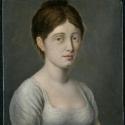
This audio capsule is inspired from the diary of lady and poet Amélie Panet-Berczy (1789‒1862). She lived in Joliette.
00:01 - 01:11
Do you find it surprising that a seigneuress vacationed in Kamouraska before the building of the railway?
But it’s true! I, Louise-Amélie Panet Berczy, Seigneuresse d’Ailleboust, holidayed in Kamouraska for the first time in 1814, with my sister Marie-Anne. We two women made the journey by carriage quite alone -- the whole 400 kilometres from Montreal! We knew that the air of Kamouraska would be good for my sister’s delicate health. It most certainly was: Marie-Anne came back a different woman! I would even say that she felt the benefits of it for several years afterwards. It was a wonderful holiday, both for rest and for entertainment.
We returned to the same place in 1840. I remember it as if it were yesterday. Steamboats would occasionally dock at Kamouraska but we preferred to travel by calash. As we were already in Quebec City, it was a mere two-day journey to reach Kamouraska -- nothing at all!
01:12 - 02:11
When we arrived at the inn, our host, Monsieur Monier, was there to help us descend from the carriage. He treated us like royalty, taking great care with my sister’s guitar, which he called the “big violin.” He led us into a well-furnished room and brought us silver-plated candlesticks. The innkeeper was well-intentioned but our supper was rather -- let us say -- rustic: tea, bread and butter, tough grilled beef, and dubious-tasting pies accompanied by dry biscuits. A pity -- I hadn’t eaten since breakfast!
Briefly said, the greatest refinement was not to be found at the inn. In the village, on the other hand, we met several distinguished people, including a banker cousin of ours and Dr. Étienne-Paschal Taché. As you know, Taché was later prime minister during the union of the Canadas and one of the most fervent proponents of confederation!
02:12 - 02:58
The day after our arrival was the occasion of a memorable excursion. Madame Taché, Seigneuress of Kamouraska, came to collect us. On the St. Pascal road, we were obliged to get out of our carriage to cross a bridge very close to the mill. It was a chance to pick some lovely bell-shaped flowers and make a magnificent wildflower bouquet. Some children came to talk to us. In the river, they had found a pink, shimmering pearl the size of a large pea, and two smaller ones, white and round. These were offered to us as gifts.
What wonderful memories! This was but a few years before thousands of tourists began to come by train or steamboat to the beaches of eastern Quebec.

